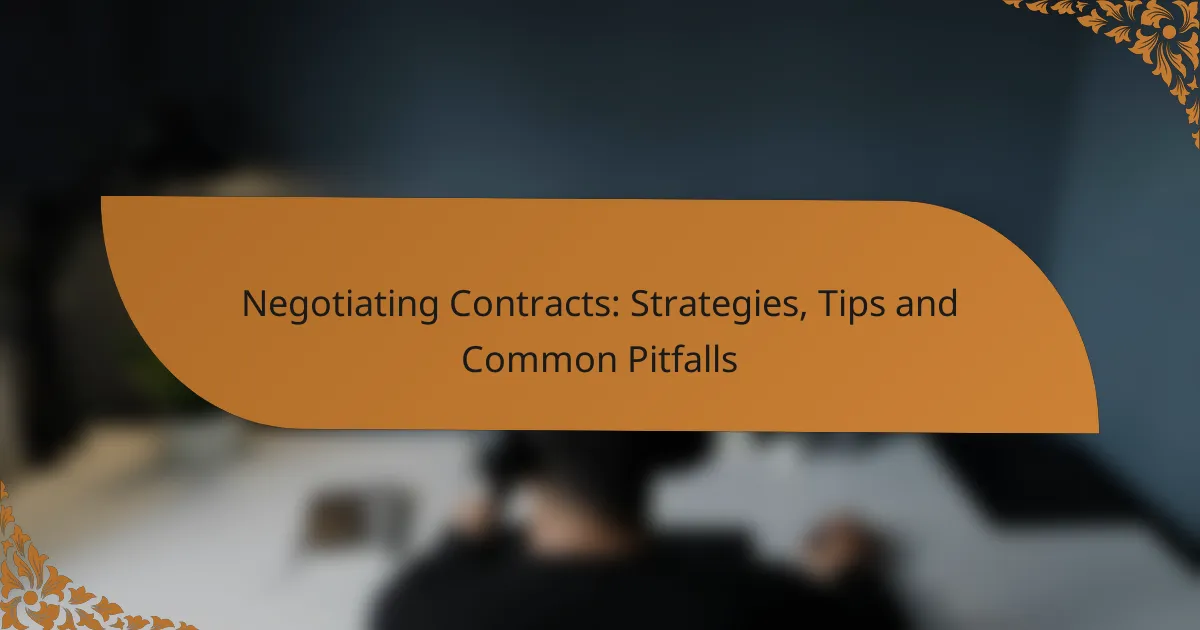Negotiating contracts effectively requires a blend of preparation, relationship-building, and a keen understanding of the other party’s needs. By employing strategic approaches and being aware of common pitfalls, such as overlooking details and mismanaging timelines, negotiators can foster agreements that are beneficial for all involved. Selecting the appropriate negotiation style is essential for navigating these discussions successfully and achieving desired outcomes.
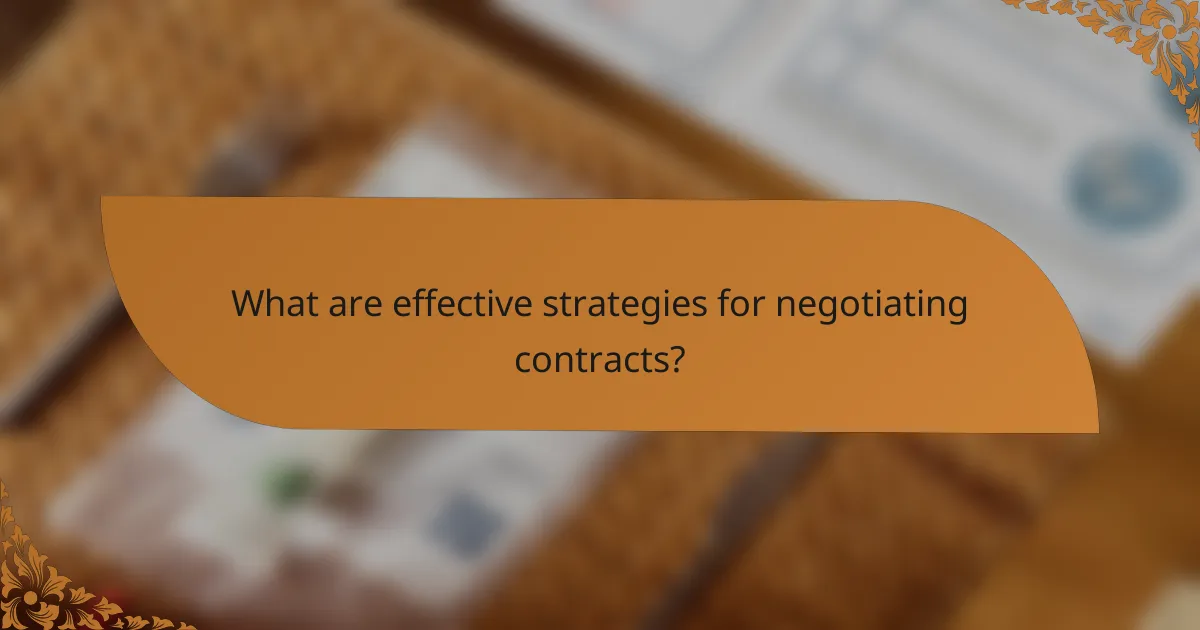
What are effective strategies for negotiating contracts?
Effective strategies for negotiating contracts include thorough preparation, building strong relationships, and understanding the needs of the other party. These approaches can lead to mutually beneficial agreements and reduce the likelihood of conflicts.
Preparation and research
Preparation is crucial in contract negotiations. Gather relevant information about the other party, including their goals, previous contracts, and negotiation history. This knowledge allows you to anticipate their needs and tailor your approach accordingly.
Additionally, familiarize yourself with industry standards and benchmarks. Knowing typical terms and pricing can help you identify unreasonable demands and strengthen your position.
Building rapport
Establishing a good relationship with the other party can significantly impact the negotiation process. Take the time to connect on a personal level, which can create a more collaborative atmosphere. Simple gestures like active listening and showing empathy can go a long way.
Consider informal discussions or meetings before formal negotiations to build trust. A positive rapport can lead to more open communication and willingness to compromise.
Leveraging negotiation tactics
Utilize various negotiation tactics to enhance your position. Techniques such as anchoring—starting with an initial offer that sets the tone for negotiations—can influence the final outcome. Additionally, employing the “BATNA” (Best Alternative to a Negotiated Agreement) concept helps you understand your options if negotiations fail.
Be mindful of timing; knowing when to push for concessions or when to pause can be critical. Effective negotiators often use silence strategically, allowing the other party to fill the void with concessions or additional information.
Understanding the other party’s needs
Recognizing the other party’s needs is essential for successful negotiations. Ask open-ended questions to uncover their priorities and concerns. This understanding can help you propose solutions that address their interests while still meeting your objectives.
Consider creating a list of potential trade-offs that could satisfy both parties. By demonstrating flexibility and a willingness to accommodate their needs, you can foster goodwill and facilitate a smoother negotiation process.
Using clear communication
Clear communication is vital in contract negotiations. Ensure that your proposals and counteroffers are articulated clearly and concisely. Avoid jargon or overly complex language that could lead to misunderstandings.
Regularly summarize key points during discussions to confirm mutual understanding. This practice not only clarifies positions but also reinforces agreement on critical issues, reducing the risk of disputes later on.
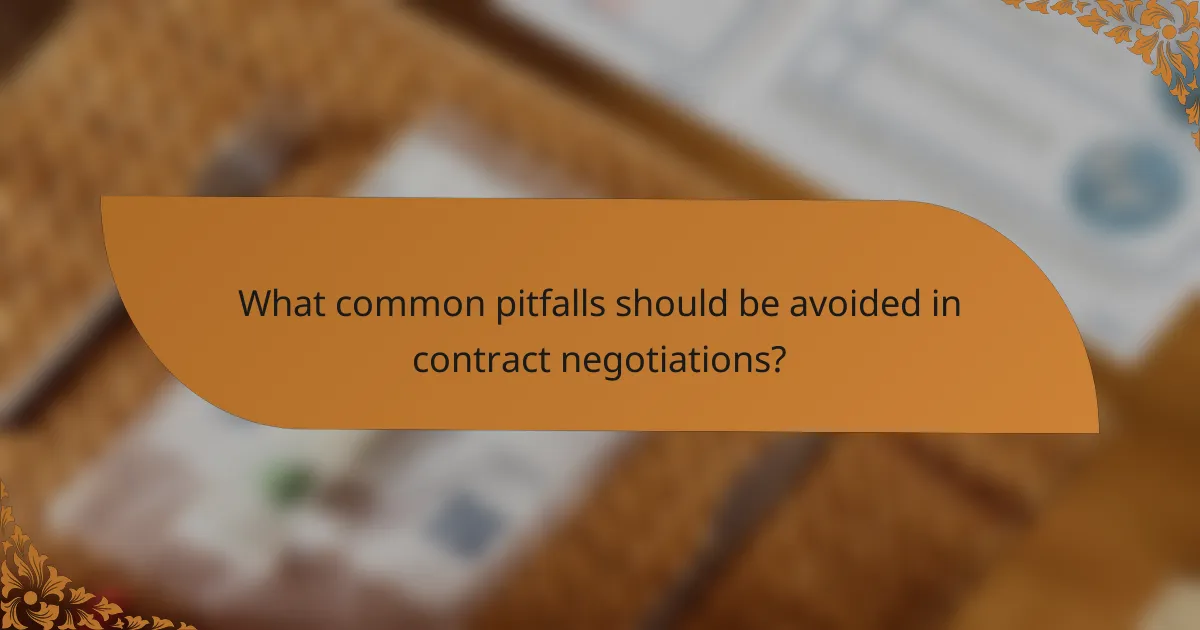
What common pitfalls should be avoided in contract negotiations?
Common pitfalls in contract negotiations include overlooking critical details, mismanaging timelines, neglecting cultural nuances, and adopting an overly aggressive stance. Avoiding these issues can lead to more favorable outcomes and smoother agreements.
Failing to read the fine print
Reading the fine print is essential in contract negotiations, as it often contains crucial terms and conditions that can significantly impact the agreement. Missing these details can lead to misunderstandings or unexpected obligations.
Always take the time to review every section of the contract, especially clauses related to termination, liability, and dispute resolution. Consider creating a checklist of key points to verify before signing.
Underestimating the importance of deadlines
Deadlines in contract negotiations are critical, as they can dictate the pace of discussions and the timing of deliverables. Missing a deadline can result in lost opportunities or strained relationships.
Establish clear timelines for each phase of the negotiation process and ensure all parties are aware of these deadlines. Use reminders and follow-ups to keep everyone on track and avoid last-minute rushes.
Ignoring cultural differences
Cultural differences can greatly influence negotiation styles and expectations. Ignoring these can lead to miscommunication and conflict, potentially derailing the negotiation process.
Research the cultural norms of the other party, especially if negotiating internationally. Understanding their approach to negotiation can help tailor your strategy and foster a more collaborative environment.
Being too aggressive
While assertiveness can be beneficial in negotiations, being overly aggressive can alienate the other party and hinder progress. A confrontational approach may lead to a breakdown in communication and trust.
Focus on building rapport and finding common ground. Use active listening techniques and aim for a win-win outcome rather than dominating the conversation. This approach can lead to more sustainable agreements.

How to choose the right negotiation style?
Choosing the right negotiation style is crucial for achieving favorable outcomes. It involves understanding your goals, the context of the negotiation, and the dynamics of the relationship with the counterparty.
Collaborative vs. competitive styles
Collaborative negotiation focuses on mutual benefit and problem-solving, aiming for win-win outcomes. In contrast, competitive negotiation prioritizes individual gain, often leading to win-lose scenarios. Selecting between these styles depends on the relationship with the other party and the stakes involved.
For example, in a long-term partnership, a collaborative approach may foster trust and cooperation, while a competitive style might be more appropriate in one-off transactions where maximizing profit is the primary goal.
Assessing the context of the negotiation
The context of the negotiation significantly influences the choice of style. Factors such as the nature of the relationship, the stakes involved, and the cultural background of the parties can dictate the most effective approach. Understanding these elements helps in tailoring your strategy to the situation.
For instance, in cultures that value harmony and consensus, a collaborative style may be more effective. Conversely, in high-stakes business deals, a competitive style might be necessary to secure the best terms.
Adapting to the counterparty’s style
Adapting to the counterparty’s negotiation style can enhance communication and lead to better outcomes. Observing their approach—whether collaborative or competitive—allows you to adjust your tactics accordingly. This flexibility can help in building rapport and facilitating agreement.
For example, if the other party is assertive and competitive, adopting a more assertive stance may prevent being overpowered. On the other hand, if they are cooperative, embracing a collaborative approach can foster a more productive dialogue.
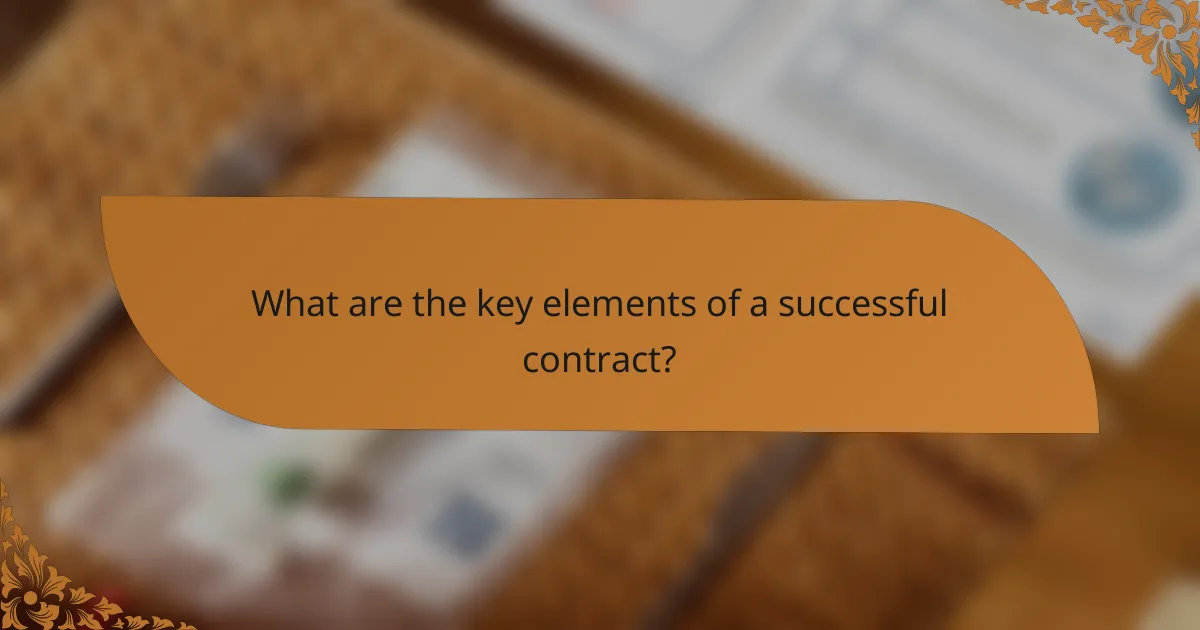
What are the key elements of a successful contract?
A successful contract includes clear terms, mutual agreement on deliverables, defined timelines, and mechanisms for dispute resolution. These elements ensure that all parties understand their obligations and can effectively manage expectations throughout the contract’s duration.
Clarity of terms
Clarity of terms is crucial in a contract to avoid misunderstandings. Each term should be defined precisely, leaving no room for ambiguity. For instance, instead of saying “reasonable time,” specify a timeframe, such as “within 30 days.”
Use straightforward language and avoid legal jargon whenever possible. This approach helps all parties comprehend their rights and responsibilities, reducing the likelihood of disputes later on.
Mutual agreement on deliverables
Both parties must agree on the deliverables to ensure that expectations align. Clearly outline what each party is responsible for providing, including quality standards and specifications. For example, if a contractor is hired to build a website, detail the features and functionalities expected.
Consider using a checklist format for deliverables to facilitate mutual understanding. This can help both parties track progress and ensure that all agreed-upon items are completed satisfactorily.
Defined timelines and milestones
Defining timelines and milestones is essential for project management within a contract. Establish specific deadlines for each phase of the project, which helps maintain accountability. For example, you might set a milestone for the completion of the initial draft of a report within two weeks.
Regularly review these timelines and adjust them if necessary, but ensure that any changes are documented and agreed upon by both parties to avoid confusion.
Dispute resolution mechanisms
Incorporating dispute resolution mechanisms into a contract can save time and resources if conflicts arise. Specify how disputes will be handled, whether through mediation, arbitration, or litigation. For instance, you might agree to resolve disputes through mediation before pursuing legal action.
Clearly outline the steps involved in the dispute resolution process, including timelines for each step. This clarity can help both parties navigate conflicts more effectively and maintain a professional relationship.
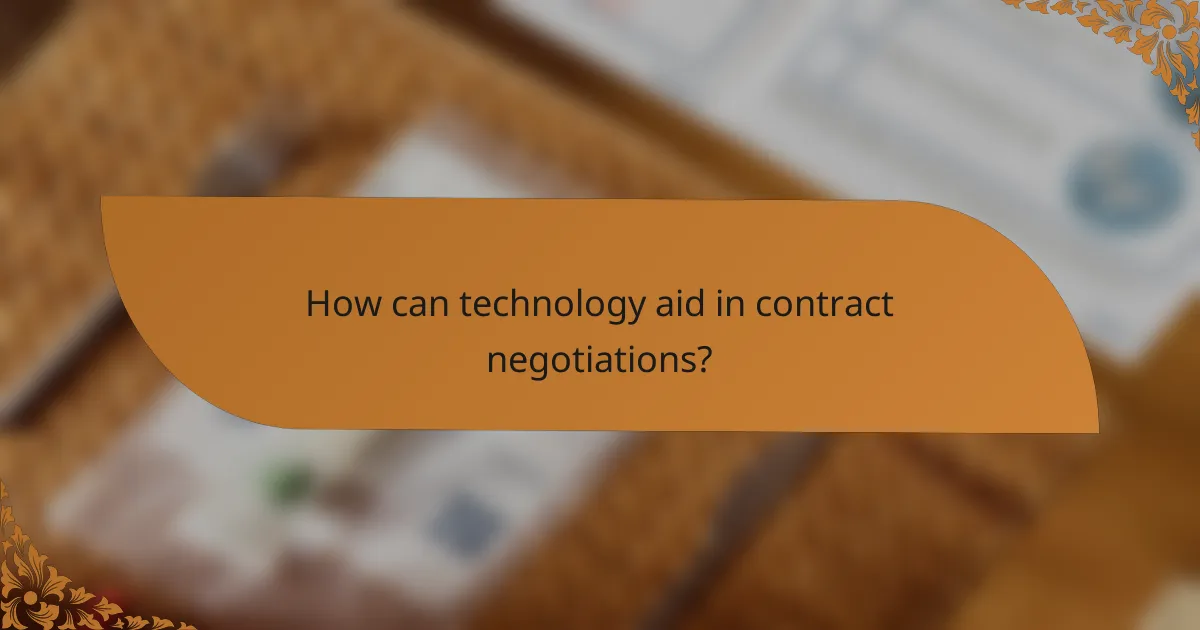
How can technology aid in contract negotiations?
Technology can significantly enhance contract negotiations by streamlining processes, improving communication, and ensuring better compliance. Tools such as contract management software and digital collaboration platforms allow parties to share documents, track changes, and manage deadlines efficiently.
Contract Management Software
Contract management software centralizes all contract-related documents and communications, making it easier to access and review terms. These platforms often include features like version control, automated reminders for key dates, and analytics to assess contract performance. By using such software, organizations can reduce the time spent on administrative tasks and focus on strategic negotiations.
Digital Collaboration Tools
Digital collaboration tools facilitate real-time communication between negotiating parties, allowing for quicker feedback and decision-making. Applications like Slack or Microsoft Teams enable instant messaging and file sharing, which can expedite the negotiation process. Utilizing these tools can help avoid misunderstandings and keep all stakeholders aligned throughout the negotiation.
Data Analytics
Data analytics can provide insights into past contract performance, helping negotiators make informed decisions. By analyzing historical data, teams can identify trends, assess risk factors, and benchmark against industry standards. This information can guide negotiations to achieve more favorable terms and conditions based on empirical evidence.
e-Signature Solutions
e-Signature solutions simplify the signing process by allowing parties to sign contracts electronically, eliminating the need for physical documents. This not only speeds up the finalization of agreements but also enhances security and compliance. Many e-signature platforms comply with regulations like eIDAS in Europe and ESIGN in the U.S., ensuring that signed contracts are legally binding.
